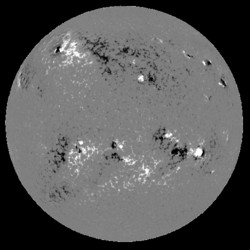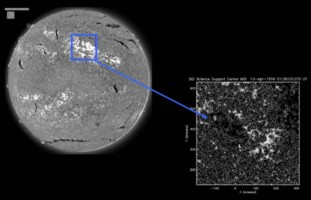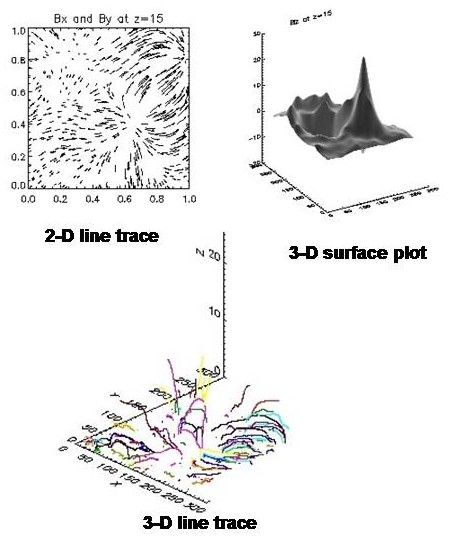|
Karen's Homepage
Introduction to Research
Goodness-of-Fit
Spearman Rank Order Correlation
Magnetic Field Extrapolation
Sigmoid and Filament Comparison
Where do we go from here?
Without Whom
|
Magnetic Field Extrapolation
This summer, we began to focus on
the magnetic structure of the progenitor before it erupted as well as the
overall global magnetic field, building tools along the way to help us
understand what is going on. The most important tool we have developed so
far has been a program that extrapolates the magnetic field of a region on
the Sun.
|
The program uses a line of sight magnetogram (like the one seen to the
right) to determine the z-component of the magnetic field across the
region. It then uses inverse Fourier transforms to determine the x-, y-
and z-components of the magnetic field.
|

|
The program requires no inputs to run. Once called, it reads in a file
that contains the dates, times and locations of all the magnetograms
downloaded to date, prints that file on the screen and prompts the user to
choose the magnetogram they would like to have loaded. If the user
attempts to choose a file that is not on the list, they are notified of
their error and asked to choose again. The appropriate fits file is then
loaded and read into the program. This file is then converted into a map
and run through a modified version of the IDL program sub_map.
Sub_map plots the magnetogram and allows the user to select a subregion.
The subregion is then converted to a 256 by 256 map centered on the middle
of the location of the chosen area and outputted for further use.

|
It is necessary to make the outputted array a factor of 2^n so that it can
be run through the magnetic field extrapolation program without anomalous
outputs. The map of the selected sub-region, as seen to the left, is then
plotted for the user to view. They are given the option to accept the
region and continue with the program or to choose the area to be
extrapolated again. Once a final region is selected, the data from that
region is run through the magnet field extrapolation program.
|
In the extrapolation program,
data from the selected sub-region is run through inverse Fourier
transforms to determine the x-, y- and z-components of the magnetic field.
A 2-D image of the field lines and a 3-D surface plot of the magnetic
field are produced. The program outputs three 3-D arrays, one for each
component of the magnetic field. The user is again given the option to
reselect the area of extrapolation or continue on with the program. Next,
the components of the magnetic field are run through a line tracing
program, which chooses a point at z=0 and interpolates the direction of
the field line to the next point, until it has done so 2,500 times for
each line. The user has the option to specify how many lines he wants to
see, but the default is 50. The lines are then plotted in 3-D. The line
tracing program outputs a cube holding the points that were connected by
the trace, allowing the user to retrace the lines and view them at any
angle. Finally, jpegs of all the images produced, along with a data file
containing the information about the selected region and the extrapolated
magnetic field components, are saved to the directory from which the
original magnetogram came. The user is notified of the location of these
files and the program is exited.
The program has three keywords, which allow the user to customize how it
is used. The keyword "small" allows the user to select a 128 by 128
subregion from which the magnetic field will be extrapolated. This is
useful for focusing in on smaller regions as well as helping the program
to run faster. The keyword "directory" allows the user to specify the
directory into which all of the files are saved rather than using the
default. The keyword "nops" allows the user to prevent the program from
saving any files at all. The optional outputs of the program include the
infromation associated with the selected sub-region, components of the
magnetic field and a data cube containing the lines connected by the line
tracing program.
|

|
Now that we have created most of the tools necessary to analyze the
magnetic fields of the progenitors, we want to see if there is any
correlation between them and the direction of the magnetic field of a
cloud when it reaches 1 AU. Currently there exist both large-scale and
small-scale models that attempt to predict the leading field direction of
magnetic clouds. Large-scale models function on the premise that
eruptions are globally defined events whose orientations correlate with
the solar dipole. Small-scale models, on the other hand, assume that only
the local fields of the active region are what influence the leading
field. However, neither of these models has been able to predict the
leading field direction of magnetic clouds with accuracy much greater than
that of flipping a coin. Thus, we have opted for an intermediate model in
between these two extremes. We will be using a potential source surface
model to describe the 3-D structure of the magnetic field in the corona
which directly overlies the progenitor.
|

